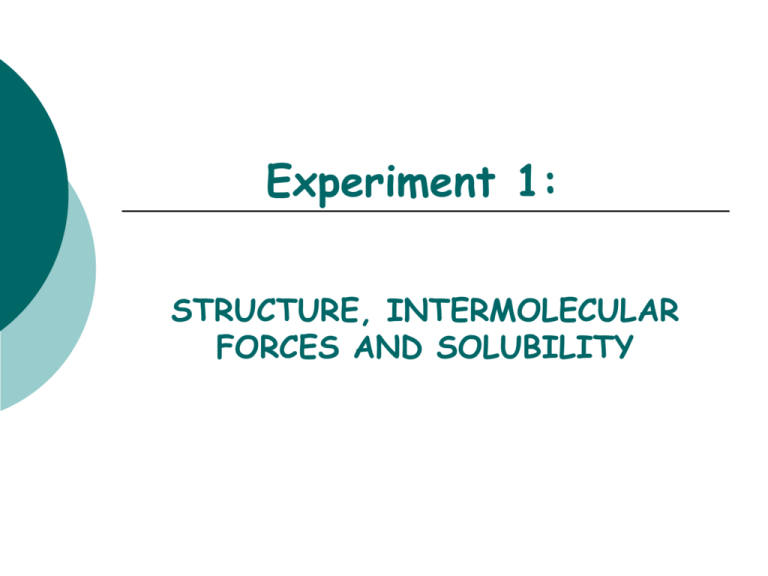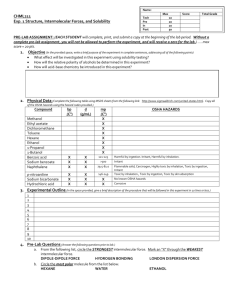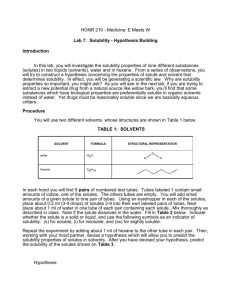Intermolecular Forces & Solubility: Chemistry Presentation
advertisement

Experiment 1: STRUCTURE, INTERMOLECULAR FORCES AND SOLUBILITY ROLE OF INTER- AND INTRAMOLECULAR FORCES physical state; solid, liquid & gas solid vs. liquid: (fat vs. oil) liquid vs. gas: (C2H6O isomers: dimethyl ether vs. ethanol) distillation; difference in BP (oC) extraction; difference in solubility and partition coefficient. Chromatography: different IMF between analyte and stationary vs. mobile phase Oil and vinegar dressing GC of alkanes, TLC, HPLC of analgesics Biology secondary structure of proteins: H-bonding between amino acids DNA and DNA-RNA base pairing: H-bonding between base pairs INTERMOLECULAR FORCES London Dispersion Forces: weak attractive forces caused by instantaneous dipoles in molecules. Dipole-Dipole Forces: Electrostatic attraction between polar molecules. Ion-Dipole Forces: Electrostatic attraction between an ion and a polar solvent. Hydrogen Bonding: (2-3 kcals/mole) Electrostatic attraction between the very electropositive H of -O-H and -N-H bonds with the negative end of other dipoles, especially with oxygen and nitrogen atoms. DIPOLE - DIPOLE FORCES: Dipole moment m: Electrostatic attraction between polar molecules. measure of the unevenness of electron density in a bond or molecule. depends on both electronegativity of atoms and on molecular geometry. + H - Cl m = 1.08 D H + C H - - + - O O C O m = 2.33 D m = 0.00 D HYDROGEN BONDING + O H donor + N H O O donor acceptor donor acceptor + O H + N H N acceptor donor N acceptor H-Bond donors and acceptors R H water H alcohols phenols R N H H R N H R O .. R C O .. H 1o amines 2o amines carboxylic acids O .. R C N H R .. .. .. .. .. OH .. .. .. .. O .. amides R ethers aldehydes .. .. O R C H O R C R ketones O .. R C O .. R esters .. R N R R 3o amines R . .O .. N .. + O .. .. R .. O .. .. .. H-Bond acceptors .. .. H .. O .. nitro compounds GOALS OF LAB Introduction to drawing structures. Introduction to inter- and intra-molecular forces between organic molecules. Through solubility testing, discover relationship between structure, intermolecular forces and solubility. EXPERIMENTAL OUTLINE A: Test solubility of compounds in hexane and water. B: Test solubility of organic liquids in water. C: Test solubility of alcohols in hexane and water. D: Test solubility of organic solids in diethyl ether, water, acidic and basic solutions. Table of Common Organic Solvents Solvent MF MW o Bp ( C) Density (g/mL) Hazards* Hexane CH3(CH2)4CH3 C6H14 86.17 68.7 0.659 Flammable Toxic Toluene C6H5CH3 C7H8 92.13 110.6 0.867 Flammable Toxic Diethyl ether CH3CH2OCH2CH3 C4H10O 74.12 34.6 0.713 Flammable Toxic Dichloromethane CH2Cl2 CH2Cl2 84.94 39.8 1.326 Ethyl Acetate CH3CO2CH2CH3 C4H8O2 88.10 77.1 0.901 Toxic, Irritant Cancer suspect Flammable Irritant Acetone CH3COCH3 C3H6O 58.08 56.3 0.790 Flammable Irritant 1-Butanol CH3CH2CH2CH2OH C4H10O 74.12 117.7 0.810 Flammable Irritant 1-Propanol CH3CH2CH2OH C3H8O 60.09 97.0 0.804 Flammable Irritant Ethanol CH3CH2OH C2H6O 46.07 78.5 0.789 Flammable Irritant Methanol CH3OH CH4O 32.04 64.7 0.791 Flammable Toxic Water HOH H2O 18.02 100.0 0.998 SAFETY CONCERNS All solvents used in today’s lab are volatile. Wear safety goggles at all times, and use fume hoods. WASTE DISPOSAL All waste from this experiment goes into the bottle marked: “Solubility Waste (IMF)”.





